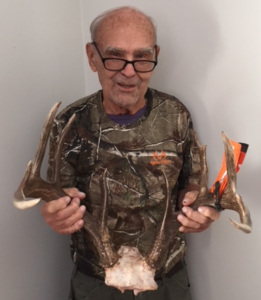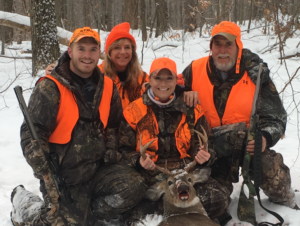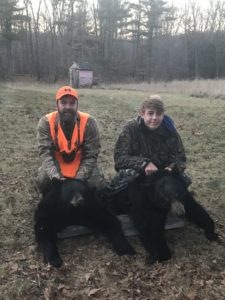A journey that started sixty-five years ago for one Hancock man came to a pinnacle this past January when he and his two sons travelled to Las Vegas where they received North American hunting awards.
In 2014, Arthur Goodrich, now 82, was awarded the Super Ten of North American Big Game by the Grand Slam Club/Ovis. The award is given to hunters who legally harvested and registered 10 North American Big Game animals, one in each category. The categories are: moose, elk, big horn sheep, mountain goat, bear, cougar, bison antelope, caribou and deer.
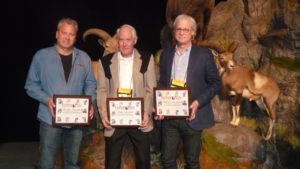 Arthur Goodrich had been one of only two MA residents to have ever received the award. This year, his sons Dr. William (Bill) and George joined him as each were recognized for their own Super Ten. Arthur also added an additional award to his long list – a Platinum Award for a Kodiak Brown Bear that scored 26 11/16 in the Bonne & Crocket Club record book. George received a silver award for a Kodiak Brown Bear from the same hunt that scored 26 3/16 in the Bonne & Crocket Club record book.
Arthur Goodrich had been one of only two MA residents to have ever received the award. This year, his sons Dr. William (Bill) and George joined him as each were recognized for their own Super Ten. Arthur also added an additional award to his long list – a Platinum Award for a Kodiak Brown Bear that scored 26 11/16 in the Bonne & Crocket Club record book. George received a silver award for a Kodiak Brown Bear from the same hunt that scored 26 3/16 in the Bonne & Crocket Club record book.
Arthur, who was born and raised in Pittsfield, started hunting at age 15. He was taught to hunt by his father and neighbors. His first harvest for the Super Ten award was a White Tail Deer in Windsor, MA as a teen. His last was a Mountain Lion in Idaho in December 2012. After receiving the prestigious award, he continued hunting into his eighties, usually with his sons to aid them in their own journeys to the Super Ten. He has hunted in 10 states and 4 Canadian provinces.
“It is a sport and a challenge,” says Arthur who traveled to Reno, Nevada in January 2014 with his wife, children, and siblings to accept his award. “It was so exciting and I was so proud of him,” said his wife of 60 years, Elaine, of watching her husband receive the honor. When they travelled to Las Vegas in January, the honor was magnified. Hunting has always been a family affair and Arthur and Elaine were able to watch their sons achieve what their father did only a few years earlier.
The family’s hunts have taken them far away from their Hancock homes, hiking up to 10,000 feet to shoot a Mountain Goat in British Columbia to the varied temperatures of Alaska Range, AK hunting a Dall Sheep. Arthur says that his Dall Sheep is a highlight of his ten hunts. The Boone & Crocket Club recognized him in 2009 for having the 19th largest sheep on record, which scored 164-4/8 points in the 27th North American Big Game Awards.
Most of Bill and George’s hunts for their Super Ten were completed in the company of their father. When they hunted Antelope in Wyoming in 2012, they were even joined by a member of the third generation, Bill’s son Collin, who harvested his own Antelope as well.
Even though the Super Ten is considered a lifetime achievement award, the family has no intention of stopping, given their passion for the sport.
Fly Fishing Film Tour
On Thursday, March 1, the Taconic Chapter of Trout Unlimited is bringing the 2018 premier of the Fly Fishing Film Tour to Great Barrington, MA at the Barrington Brewery, Crissy’s Barn. You are invited to see some amazing footage of fly fishing around the world. This is their third film tour. Last year it was a big hit, with amazing sights. Door prizes and raffles will be held, including a 9 foot, 5-weight fly rod which was built by local angler Allen Gray.
Doors open at 6:30 and the show starts at 7 PM and runs to about 9 PM. Tickets cost $12 in advance and $15 at the door. Click onto https://flyfilmtour.com/buy-tickets/ to buy your tickets. Tickets are available locally in advance from any TU Board Members. For information please contact William Travis at traviswdt547@gmail.com or 413/822-7934.
Basic Hunter Education Course
There will be a basic hunter education course held at the East Mountain Sportsman Club, 312 Henderson Road, Williamstown on April 9, 13, 16, 20, 23 and 27. All 6 dates meet from 6 to 9 PM. You must attend all class dates and times to successfully complete the course.
If you are interested in this course and wish to enroll, call (508) 389-7830 immediately; students are enrolled first-come, first-served, and courses do fill quickly.
Beagle Club Rabbit Hunt Results
Berkshire Beagle Club spokesman John Demary reported that 17 hunters participated in its annual Rabbit Hunt which was held on February 10. The running was not great, with only one Snowshoe Hare being taken. Jordan Goerlach, of Hinsdale Mass, took that hare which weighed 2.95 lb. He got it in front of his beagle Marley. Dick Kalisz won $100 in the 50/50 raffle.
According to Demary, those who didn’t have any luck had a wonderful consolation prize: Venison Meat Sauce, Venison Meat balls & Spaghetti, Venison Chili, Chicken Broccoli Alfredo & Bear Stew, all prepared by BBC members Teddy Billis who did most of the cooking along with Tim O’Keefe, and Dick Kalisz.
Large bear
In January, the Berkshire Eagle received a photo from Mr. Richard M. Coty of Lee. The photo was of his grandson who harvested a 507.5-pound bear (live weight) this year. The picture was printed out in black and white and was completely useless for use in print. There was no phone number with which to reach the grandfather in order to follow up. I contacted the DFW Western District Supervisor, Andrew Madden, to see if he had any information about this large bear; however, there was no record of such a bear being shot in Massachusetts. So, with no other avenues to pursue, the story was dropped.
Last week, Richard called me and the required information was obtained. It turned out that the bear was shot in North Carolina by his grandson Andrew Michael Coty. I told Richard that the bear season has been closed for a couple of months now and it was too late to run the story. After ending our conversation and hanging up, I began to have second thoughts.
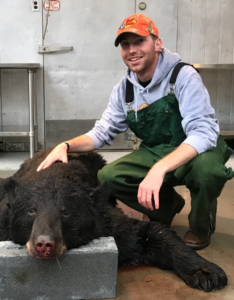 You see, Andrew is a sergeant in the US Army, 82nd Airborne Division stationed at Fort Bragg, NC. He has spent the last 5 years defending our country. The least we could do is show the picture of his bear of which he was so proud. It was also our chance to congratulate him and to thank him for his military service. The sports editor, Geoff Smith, agreed.
You see, Andrew is a sergeant in the US Army, 82nd Airborne Division stationed at Fort Bragg, NC. He has spent the last 5 years defending our country. The least we could do is show the picture of his bear of which he was so proud. It was also our chance to congratulate him and to thank him for his military service. The sports editor, Geoff Smith, agreed.
So, working with Andrew’s father Bill, who also lives in NC, we began the process of selecting the best picture and obtaining a little background information. Incidentally, upon Andrew’s discharge, he will pursue a career in the NC Highway Patrol. He was probably influenced by his uncle Dean Leitschuh who helped him get the bear out of the woods and who is a member of the NC Highway Patrol.


